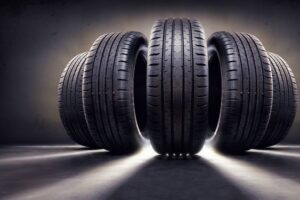The technical word for the phenomena of Car Tyres in Stockport slipping or skidding on a wet surface is hydroplaning or aquaplaning. You can notice your car’s tyres suddenly swerving away while driving on wet roads or on dry roads after a small rain. As the tyres lose traction, you become unable to manage the steering. It’s called hydroplaning.
What Causes Hydroplaning?
Roads that are damp can hydroplane. The ability of the tyres to efficiently distribute the water is sometimes questioned. The pressure exerted in front of the wheel causes the water to get forced beneath the tyre as a consequence. As a result, a thin layer of water forms on the tire’s surface, separating it from the road. At this point, the car loses control and traction.
During this period, the remaining oil on the road surface reacts with the rainwater, creating a slippery surface. Vehicles frequently hydroplane on this surface, especially those moving at speeds of 55 to 60 kph. Such occurrences can be extremely dangerous and may even result in fatalities.
Actions You Can Take To Prevent Hydroplaning
Prevention is always preferable to treatment. Although hydroplaning may occasionally be unavoidable, keeping the following in mind may help you avoid such occurrences:
Cruise control: This function is quite helpful. It enables the driver to specify a certain speed that the vehicle will maintain without additional input from the driver. However, it is not advised to use cruise control when driving in the rain. Driving in the rain is dangerous, and the driver must constantly monitor their speed to reduce the chance of hydroplaning.
Tyre pressure: It’s crucial to regularly check the tyre pressure for the automobile or bike’s performance as well as to prevent hydroplaning. Low tyre pressure prevents the treads from maintaining good contact with the road, which prevents them from uniformly dispersing the water. The likelihood of the car hydroplaning rises as a result.
Tyre treads: The purpose of tyre treads is to push snow or water away from the tyres. It is not intended to offer traction. The likelihood of a hydroplaning occurrence will increase if the treads on the tyres wear down since they can scarcely move the water.
Never tailgate: It is risky to tailgate, especially while it is pouring. Tailgating is the act of driving very closely behind another vehicle on the road. Although hydroplanes may not linger for very long, following another vehicle increases the likelihood of a deadly accident. Keeping a safe distance from other drivers is always advised when driving.
Tyre balancing: It’s critical to maintain routine tyre inspections and align your tyres at certain intervals. The wheels should get rotated and balanced after each oil change, or around every 11,000 to 16,000 kilometres.
Slowing down: When a car is travelling at an average speed of 55 to 60 kmph, hydroplaning usually happens. As soon as it begins to rain, it is always preferable to drive more slowly. You’ll be safer if you drive less slowly than the speed limit. If you are moving quickly, it will be tougher for your tyres to push the water away. Avoiding sudden accelerations is essential since they increase the risk of hydroplaning.
Choosing the proper set of tyres: Choosing the right set of tyres may prevent numerous accidents. It is always advised to invest a little more money on high-quality tyres. Driving on bare tyres is not recommended. Drivers in nations with heavy rains can purchase a pair of tyres made specifically for slick surfaces.
Avoiding collected water: Driving across standing water raises the risk of hydroplaning. When possible, avoid standing water on the road; nevertheless, if this is not possible, it’s advised that you proceed extremely slowly.
Observing the vehicles in front: You can gauge the state of the roads by observing how the vehicles in front of you drive. An excessive amount of water flowing from the car’s tyres is a sign that the lane has accumulated water. The greatest thing you can do in such circumstances is to slow down and, if feasible, change lanes.
Actions You Can Take To Avoid Hydroplaning:
Following are some tips to bear in mind if your car begins to hydroplane and how to remedy the situation:
- The key to healing is maintaining your composure. Since hydroplanes are short-lived, maintaining your composure will help you avoid accidents.
- Stop moving forward so quickly. This will also assist in gradually moving the weight to the front of your car, allowing you to restore control.
- Avoid slamming on the brakes. If you apply too much pressure during braking, you risk locking your wheels, which will cause you to entirely lose control of the vehicle and cause it to slide.
- If your vehicle has a manual gearbox, depress the clutch and allow the vehicle to slow down naturally.
By using these simple tips, you may minimize your chances of Dunlop tyres Stockport hydroplaning and ensure that you can exit such scenarios without suffering significant damage.


